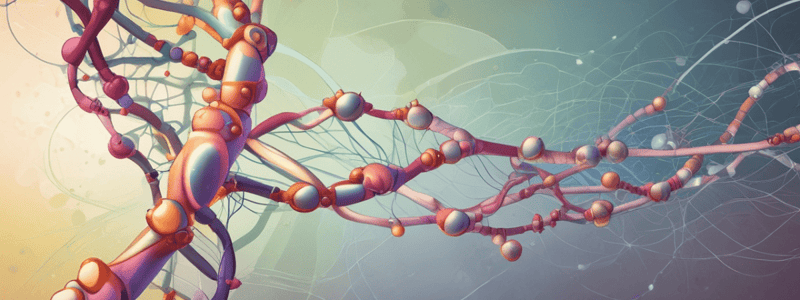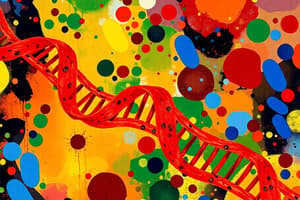Podcast
Questions and Answers
What is a key difference between DNA replication and transcription in terms of chain growth?
What is a key difference between DNA replication and transcription in terms of chain growth?
- DNA replication and transcription both involve rapid chain growth at many sites.
- DNA replication involves slower growth at few intracellular sites, while transcription involves rapid chain growth at many sites.
- DNA replication involves rapid chain growth at few intracellular sites, while transcription involves slower growth at many sites. (correct)
- DNA replication involves slower growth at many sites, while transcription involves rapid chain growth at few intracellular sites.
What is a characteristic of RNA polymerase subunits in the three domains of life?
What is a characteristic of RNA polymerase subunits in the three domains of life?
- Homologous subunits are not color coded.
- Subunits are arranged by size rather than function.
- Subunits are arranged by function rather than size. (correct)
- Subunits marked with an asterisk are not conserved among the three eukaryotic RNA polymerases.
What is shown in the crystal structures of RNA polymerases?
What is shown in the crystal structures of RNA polymerases?
- Core enzyme structures with bound proteins.
- Bound proteins that aid in template recognition.
- Core enzyme structures without bound proteins. (correct)
- Only the promoter site of the DNA.
What is the first step in the transcription process by bacterial RNA polymerase?
What is the first step in the transcription process by bacterial RNA polymerase?
What is a feature of the open-promoter complex formed by Taq RNA polymerase?
What is a feature of the open-promoter complex formed by Taq RNA polymerase?
What is the function of the RNA polymerase subunits marked with an asterisk?
What is the function of the RNA polymerase subunits marked with an asterisk?
What is a difference between DNA replication and transcription in terms of RNA accumulation?
What is a difference between DNA replication and transcription in terms of RNA accumulation?
What is the characteristic of the promoter site in transcription?
What is the characteristic of the promoter site in transcription?
What is the consequence of backtracking in an elongation complex?
What is the consequence of backtracking in an elongation complex?
What determines the frequency of transcription of E. coli genes?
What determines the frequency of transcription of E. coli genes?
What is the function of the protein in factor-dependent termination?
What is the function of the protein in factor-dependent termination?
What is the composition of the GC-rich region in factor-independent termination?
What is the composition of the GC-rich region in factor-independent termination?
What happens to the RNA-RNA duplex in factor-independent termination?
What happens to the RNA-RNA duplex in factor-independent termination?
What is the consequence of the RNA-RNA duplex formation in factor-independent termination?
What is the consequence of the RNA-RNA duplex formation in factor-independent termination?
What is the role of the A-rich segment in factor-independent termination?
What is the role of the A-rich segment in factor-independent termination?
What is the purpose of the run of four to eight A residues in factor-independent termination?
What is the purpose of the run of four to eight A residues in factor-independent termination?
What is the purpose of phosphorylation in transcription initiation?
What is the purpose of phosphorylation in transcription initiation?
What is the function of the AATAAA sequence near the end of most eukaryotic genes?
What is the function of the AATAAA sequence near the end of most eukaryotic genes?
What is the location of acetylation in core histones?
What is the location of acetylation in core histones?
What is the purpose of DNA looping in transcriptional regulation?
What is the purpose of DNA looping in transcriptional regulation?
Which of the following is NOT a step in post-transcriptional processing in bacteria?
Which of the following is NOT a step in post-transcriptional processing in bacteria?
What is the function of the TFIIA–TBP–TFIIB complex?
What is the function of the TFIIA–TBP–TFIIB complex?
Which of the following is a step in post-transcriptional processing in eukaryotes?
Which of the following is a step in post-transcriptional processing in eukaryotes?
What is the structure of the core histones?
What is the structure of the core histones?
What is the primary function of alanyl-tRNA synthetase?
What is the primary function of alanyl-tRNA synthetase?
What is the characteristic of the cleft in the glutaminyl-tRNA synthetase?
What is the characteristic of the cleft in the glutaminyl-tRNA synthetase?
What is the difference between bacterial and eukaryotic ribosomes?
What is the difference between bacterial and eukaryotic ribosomes?
What is the method used to determine the shape of the ribosomal subunits?
What is the method used to determine the shape of the ribosomal subunits?
What is the characteristic of the assembly pathway of the 30S subunit?
What is the characteristic of the assembly pathway of the 30S subunit?
What is the function of the 3' acceptor stem of the tRNA?
What is the function of the 3' acceptor stem of the tRNA?
What is the class of the glutaminyl-tRNA synthetase?
What is the class of the glutaminyl-tRNA synthetase?
What is the component of the tRNA that is represented by a detailed atomic model?
What is the component of the tRNA that is represented by a detailed atomic model?
What is the function of SF3b in post-transcriptional processing?
What is the function of SF3b in post-transcriptional processing?
What is the significance of alternative splicing in gene expression?
What is the significance of alternative splicing in gene expression?
What is the function of NTC in post-transcriptional processing?
What is the function of NTC in post-transcriptional processing?
What is the purpose of the smooth (SM) and striated (STR) exons?
What is the purpose of the smooth (SM) and striated (STR) exons?
What is the process by which the ribosome selects specific aminoacyl-tRNAs during translation?
What is the process by which the ribosome selects specific aminoacyl-tRNAs during translation?
What is the result of alternative 3'-terminal exons in the tropomyosin gene?
What is the result of alternative 3'-terminal exons in the tropomyosin gene?
What is the term for the process of selecting specific splice sites during alternative splicing?
What is the term for the process of selecting specific splice sites during alternative splicing?
What is the outcome of the tropomyosin gene organization?
What is the outcome of the tropomyosin gene organization?
Flashcards are hidden until you start studying
Study Notes
Enzymology of RNA Synthesis: RNA Polymerase
- RNA polymerase is responsible for transcription, which involves slower growth at many sites, resulting in more RNA accumulation than DNA
- The functions of RNA polymerase subunits can be determined by reconstitution
- RNA polymerase subunit structures vary in the three domains of life (bacteria, archaea, and eukarya), with homologous subunits color-coded and conserved subunits marked with an asterisk
Mechanism of Transcription
- Transcription begins with sequence-specific interaction between RNA polymerase and a promoter site, involving duplex unwinding and template strand selection
- DNA bending occurs in the open-promoter complex, with a sharp bend in the template strand
- Backtracking can occur in the elongation complex, where the enzyme slips backward, leaving the transcript terminus at the end of a non-base-paired RNA tail
- Transcription can resume either by forward sliding of the polymerase back to the original structure or by cleavage of the non-base-paired part of the transcript, creating a new base-paired 3' terminus
- The frequency of gene transcription in E. coli is largely determined by the similarity between the gene's promoter sequence and the consensus sequence
- Conserved sequences in promoters recognized by E. coli RNA polymerase include the -10 and -35 regions, with lengths of spacer sequences also shown
Mechanism of Transcription (continued)
- DNA sequences that promote factor-independent termination include a run of four to eight A residues and a GC-rich region that forms a stem-loop
- In factor-dependent termination, a protein acts as an RNA-DNA helicase, unwinding the template-transcript duplex and facilitating release of the transcript
- A model for factor-independent termination of transcription involves an A-rich segment of the template being transcribed into a U-rich mRNA segment, followed by RNA-RNA duplex formation and elimination of some base pairing between the template and transcript
Transcription and its Control in Eukaryotic Cells
- A model of the TFIIA-TBP-TFIIB-promoter complex based on crystal structures of TBP-TFIIB-TATA and TFIIA-TBP-TATA complexes
- DNA looping (perhaps mediated by nucleosomes) can bring enhancer-bound activator (or repressor) proteins into contact with TAFs associated with the core complex
- Acetylation of core histones occurs exclusively in the N-terminal domains, at highly conserved sites
Termination of Transcription in Eukaryotes
- Termination of transcription in eukaryotes involves the addition of poly(A) tails, which is signaled by the AATAAA sequence near the end of most eukaryotic genes
Post-transcriptional Processing
- Bacterial transcripts undergo post-transcriptional processing, involving both endonucleolytic and exonucleolytic cleavage
- Post-transcriptional processing in bacteria involves cleavage of the primary transcript, modification of bases, non-transcriptive nucleotide addition, and intron splicing (in a few cases)
- Alternative splicing allows one gene to specify several proteins, as seen in the tropomyosin gene organization (rat) and its seven alternative splicing pathways
Post-transcriptional Processing (continued)
- Possible mechanisms for alternative splicing by splice-site selection include the use of different splice sites, the presence of splicing enhancers or silencers, and the role of RNA-binding proteins
Translation
- Translation of an RNA message into a protein involves the ribosome moving along the message, accepting specific aminoacyl-tRNAs in succession, and selecting them by matching the trinucleotide anticodon on the tRNA to the trinucleotide codon on the RNA message
The Major Participants in Translation
- Major "identity elements" in tRNAs include the acceptor stem, the D stem, the anticodon stem, and the variable loop
- A model of the E. coli glutaminyl-tRNA synthetase coupled with its tRNA and ATP shows the tRNA fitting into a deep cleft in the synthetase, with the ATP and 3' acceptor stem of the tRNA binding to the synthetase
- Components of bacterial and eukaryotic ribosomes include the 30S and 50S subunits, with eukaryotic ribosomes being somewhat larger and more complex
The Major Participants in Translation (continued)
- Assembly map for the 30S subunit shows the obligatory nature of some protein-binding events
Studying That Suits You
Use AI to generate personalized quizzes and flashcards to suit your learning preferences.




